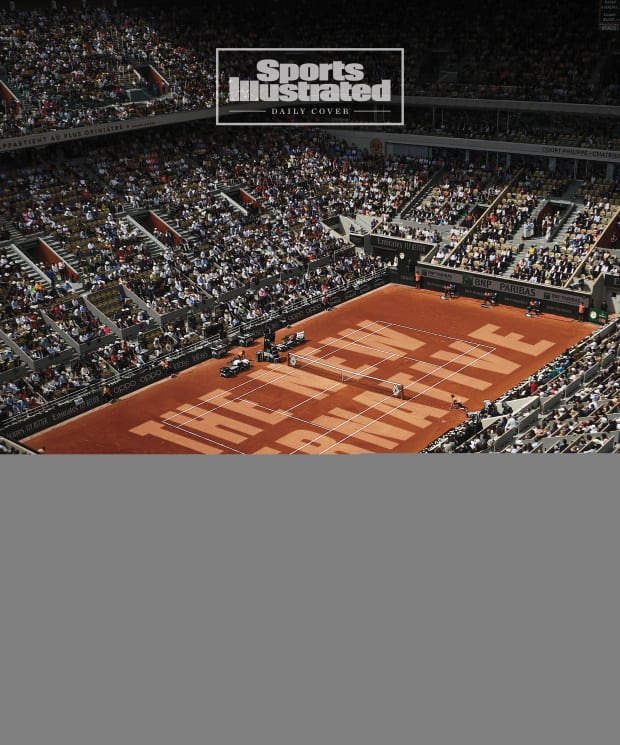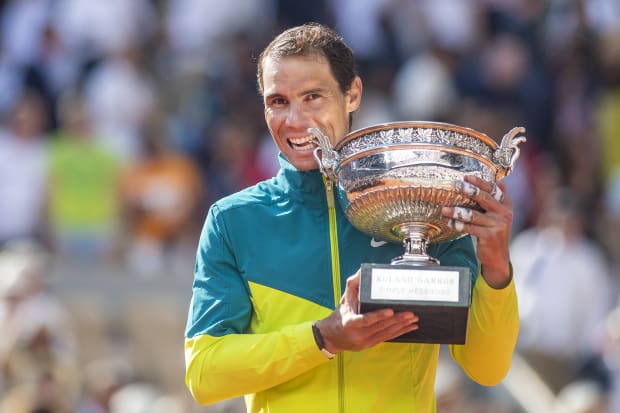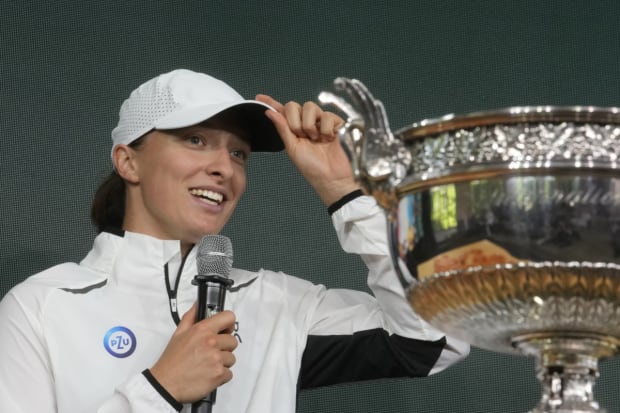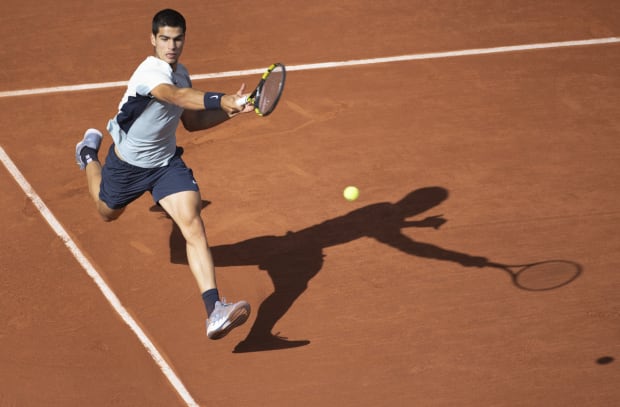It felt like a French comedy routine, one that had hardened into an annual tradition.
First, the setup: Walk through the grounds of Roland Garros, past the statue of Rafael Nadal—peeled from tennis’s Mount Rushmore—and enter its main stadium. There, Nadal stands in the anteroom before the entrance, before walking onto Court Philippe-Chatrier, which, for nearly 20 years, has doubled as his personal stage. Bandana tied tight around his head, Nadal, ever the creature of habit, begins rolling his shoulders and undertaking a series of spring-loaded kangaroo hops and stretching exercises, conscious enough not to hit his head on the ceiling.
As Nadal undertakes this elaborate backstage ritual, tournament stadium announcer Marc Maury begins his introduction, first in French and then in English. “And from Spain, the tournament champion in the years …” Then, Maury takes a deep breath and begins the tally, “2005, 2006, 2007, 2008, 2010, 2011, 2012 …” And on he goes. By the time Maury gets through all the years—we’re now up to 14—the crowd erupts into audible giggles.

Photo Illustration by Dan Larkin; Christophe Archambault/AFP/Getty Images
Which is really the only natural reaction to Nadal’s record at Roland Garros.
Since vamoosing and vamos-ing into Paris as a teenager in 2005—and promptly winning the first French Open he entered on the weekend he turned 19—Nadal has dominated this, the second major on the tennis calendar, much the same way yellow dominates the color scheme of the fluffy balls he picks off and guides with such force and accuracy. In 115 matches at the venue, Nadal is 112–3.
We could, in fact, spend the bulk of this essay trying to explain the absurdity of Nadal’s record on these clay courts. Instead, we’ll give you one representative example. It was 20 years ago that the great Pete Sampras retired from tennis with a record 14 career Grand Slam titles—more than John McEnroe and Boris Becker combined—a run that, at the time, was considered something akin to Cal Ripken Jr.’s Ironman streak, a sports milestone that would never be approached, much less eclipsed.
Well, never mind that. Nadal has won 22 majors now, tied with Novak Djokovic for the all-time lead. Nadal’s haul at the French Open alone would tie him with Sampras. Roger Federer (20 career majors), Nadal’s longtime nemesis, aptly calls his rival’s French Open record “scary but also funny.”
Sadly, though, the red light is on, and there will be no more yuks in Paris, at least not this year. A year ago, Nadal reached the finals for the 14th time and, for the 14th time, hoisted the trophy. It was a typically comprehensive cocktail of offense and defense, power and placement. But he has not been the same player since.
Injuries have always been an earmark of his career, a sort of tax on all that exertion, while his body has always gone through Grey’s Anatomy page by page. But even by his standards, he has spent the past 12 months in the breakdown lane and played sparingly since Roland Garros 2022. And when he has played, he has clearly been compromised. In January’s Australian Open, he entered as the defending champ and then limped to an early defeat, undone by a psoas injury, debilitating soreness in his upper hip. He hasn’t played a match since.

Tim Clayton/Corbis/Getty Images
On May 18 he confirmed speculation and announced, for the first time since 2005, he would be skipping Paris in the springtime. “I am not able to feel ready to compete at the standards that I need to be to play Roland Garros,” he said somberly. And just like that, the 2023 French Open became bereft. Prince without the color purple. The Matrix without Keanu.
But if Nadal isn’t a seed, he has planted one. It is somehow fitting that, in his absence, the player to beat is another Spaniard who is also physically imposing, indefatigable, violent yet gentle on the court. He might be 17 years younger, but is unmistakably cut from the same pano, old threads woven into the new fabric. You can hear Maury’s intro now: And from Spain, Carlos Al-cah-raz.
Though he ceased being a teenager last month, Alcaraz has become the present and future of men’s tennis, the spindle on which the sport currently spins. He is currently ranked No. 1. He is the top seed at this event. He is the emerging star single-handedly helping to ease the pain of the transition out of the Nadal/Djokovic/Federer era, the Lebron James–type figure after the retirement of Michael Jordan. With Federer in retirement, the Big Three have combined for one title in 2023. Alcaraz alone has won four and boasts a 30–3 season record.
“A player has not been this hyped since Nadal,” says Mats Wilander, himself a former champion in Paris. “And in both cases, it’s totally justified.”
The similarities and symmetries between Alcaraz and Nadal aren’t perfect. Nadal is a lefty, Alcaraz a righty. Alcaraz hits flatter shots drizzled with less spin and bite. He is more inclined to use a drop shot and venture to the net to volley. He might be a smidge more naturally athletic than Nadal. Alcaraz certainly possesses fewer tics and has a more conventional approach to his equipment. (Quick digression: Nadal’s kid-sized 4⅛ inch grip never got its due; it is the equivalent of Aaron Judge walking to home plate gripping a Little League bat.)
Nadal began his career coached by his uncle, who studied the sport but never played it at a high level. Alcaraz is coached by Juan Carlos Ferrero, a Spaniard who won the title in Paris 20 years ago en route to reaching No. 1 in the world. Both Alcaraz and Nadal profess they are flattered to be likened to the other, but quietly chafe at all the comparisons. Nevertheless, as Ferrero says, “How can Rafa not be an inspirational [figure]?”
Like Nadal, Alcaraz won his first major at 19, the 2022 U.S. Open, ascending to No. 1 in the rankings in the process. And this spring has done a convincing Nadal impersonation on clay, taking the titles in Barcelona and Madrid. Last week in Rome, he suffered a shock loss against Fábián Marozsán, a little-known player from Hungary ranked outside the top 100. But Ferrero (granted, hardly an objective source) makes a fair point that, unlike losing to a rival and firing them with confidence, Alcaraz can attribute last week’s loss to a simple aberration.
At least with the oddsmakers, Alcaraz has leapfrogged Djokovic, a two-time French Open champ (2016 and ’21), and, perhaps, the best clay-court player in men’s history not named Rafael Nadal. Yet, since concluding his annual romp to the title in Australia, Djokovic has been a work in regress. On account of his anti-vaccination stance, he was not permitted to play the big-ticket events at Indian Wells and Miami. This has been to the detriment of his ranking and, more critically, his rhythm. Over the past four months, he entered five events and won none. Plus, Djokovic just turned 36 on May 22, once considered retirement time in tennis years.
As for other contenders, whatever the Russian word is for “sandbag,” it applies to Daniil Medvedev. If the job of the charismatic Russian is to blast tennis balls with his awkward-but-effective strokes, he has made a hobby out of denigrating his chances on clay—it is a “broken surface” and is “so terrible” with dirt underfoot. Except his results tell another story. He took the title last week in Rome, beating a murderers’ row of accomplished clay-courters (including 2021 Roland Garros finalist Stefanos Tsitsipas in the semis). His protestations to the contrary, Medvedev is a contender in Paris, surface be damned.

AP Photo/Thibault Camus

Tim Clayton/Corbis/Getty Images
Same for the feisty Holger Rune, born only a few days before Alcaraz. Rune is one of those athletes (bless him, every sport needs a few of them) who plays to win, not to make friends or become a fan favorite. He may beef with his colleagues and may get booed before taking the court, but if it impacts his tennis at all, it’s for the better.
After out-Djokovicing Djokovic in Rome last week—beating the favorite with pinpoint strokes, ripping backhands and precision when it mattered most—Rune is up to No. 6 in the rankings. And if/when the fickle French fans turn on him in these next few weeks, so much the better. For all the players who, in the spirit of Nadal, minimize expectation at every turn, Rune openly (and rightly) articulates the “big opportunity” Paris presents. He knows the breakup of the Big Three has, for the first time in almost two decades, opened to the field.
And since no sport does irony quite like tennis, the reverse trend is afoot in the women’s game. For so long, the women’s draw were blank slates of possibilities with dozens of contenders. But so far this year, a trio—a Big Three, you might say—has come to the fore.
Iga Świątek of Poland is the defending champ, the No. 1 player in the world for more than a year now, and already among the most versatile performers in the sport’s history. But her dominance this year has been undercut. In Australia, it was Elena Rybakina of Kazakhstan, who then lost to Aryna Sabalenka of Belarus in the final. But Rybakina exacted revenge, beating Sabalenka to win Indian Wells. And Świątek beat Sabalenka to win Stuttgart. But Sabalenka beat Swiątek to win Madrid. And Rybakina beat Swiątek en route to winning Rome.
Got that? Bottom line: They are players, each in their mid-20s, who have created separation from the rest of the field. They are, far and away, the three best bets on the women’s side to win the French Open. In the end, we suspect it will be Świątek who will raise the trophy. She possesses more gears, a greater battery of options than her opponents, which is always a tennis secret superpower, but especially on clay.
On the men’s side, we’ll take the top seed there, too. Alcaraz possesses that ultimate virtue of confidence. Then he marries it with bottomless talent. He can blast winners but also can construct points. He can play offense but also defense. And at 20, his legs and live arm are a full decade younger than many of his likely opponents.
Whoever takes the men’s title is a lucky man. Nadal is known as the King of Clay, but he is also Cerberus, a sort of gatekeeping monster who prevents others from entering the kingdom. He has vowed to “probably” return in 2024, for one coda season, one last power drive, a final play for a 15th title in Paris. But he has left his post in ’23. And in his absence, there is a power vacuum. Get in while you can, gentlemen.








